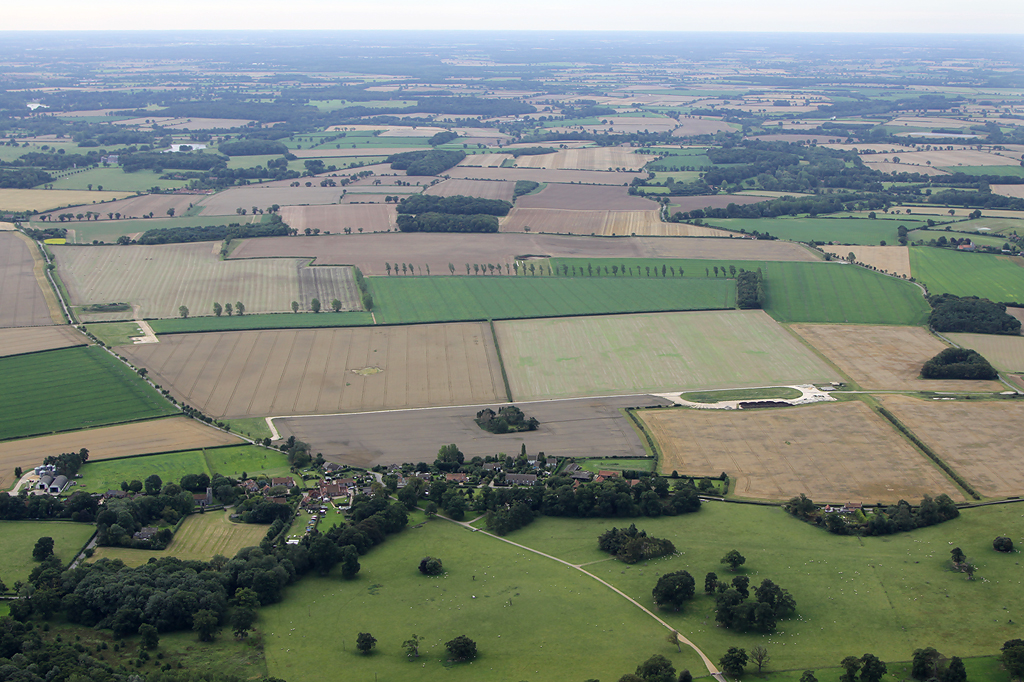52°51'38"N 001°11'22"E
Runway: 05/23 - 1463m/1500yds - grass
Runway: 09/27 - 1189m/1230yds - grass
Runway: 13/31 - 1389m/1430yds - grass
RAF Matlaske (also spelled as Matlask) was an airfield 175 km northeast of London.
Before World War II started, there was a small airfield at Matlaske, of which nothing is known. In August 1939, at the beginnng of the Phoney War, the site was approved for requisition by the Air Ministry. Construction began in the summer of 1940 and when complete, the airfield was grass-covered with two main runways. To alleviate flooding problems, the entire central landing area was covered in Somerfield wire netting. RAF Matlaske became operational in October 1940 as a satellite station to RAF Coltishall and part of 12 Group RAF Fighter Command, when Spitfires of 72 Squadron were briefly dispersed there following the bombing of RAF Coltishall. Barely operational, it was attacked by the Luftwaffe on 29 October 1940, appearantly to hit the Spitfires of 72 Squadron. Five Dornier aircraft carried out the attack, strafing the base and causing damage to parked aircraft as well as inflicting several casualties to personnel. On 12 May 1941 the Luftwaffe attacked the base again but this time they bombed using incendiary bombs. The attack had limited success with only minor damage caused and no personnel casualties.
Between November 1941 to August 1942 the base hosted 137 Sqn, one of only two RAF squadrons to fly the unique (and then still secret) twin-engine Westland Whirlwind fighter. 137 Sqn was engaged in East coast convoy patrols and anti-shipping tasks, supported by 278 Air Sea Rescue squadron, based at Matlaske from October 1941 to April 1942.
The airfield was allocated to the USAAF's Eighth Air Force as a fighter base in September 1942. Many huts were built in the area to accommodate American troops. The USAAF's 56th Fighter Group (flying P-47 Thunderbolt fighter-bombers) - perhaps better known as "Zemke's Wolf Pack", after Colonel Hubert Zemke, the group commander - used the base only briefly in March and April 1943 however. In February, while still stationed at RAF King's Cliffe, the 56th was to undertake gunnery practice on RAF ranges, using (amongst others) the aerodrome at Matlask.
From April to May 1943, 1489 Flight (RAF) conducted target towings with Hawker Henleys, Westland Lysanders, M.25 Martinets and M.9 Masters, based at RAF Coltishall and RAF Sutton Bridge, but detached to RAF Matlaske as required.
By 1 June 1943, the Air Ministry had the construction of fighter fields well underway. 10 out of a total of 22 of them were allocated to exclusive US use, and the remainder got designated as emergency landing fields. In August 1943, RAF Matlask was transferred to Eighth Air Force USAAF control and its status changed to Care and Maintenance to allow the facilities to be improved. Among others, a new control tower was built. The airfield did not re-open (in September 1944) under USAAF control, though.
When Matlaske did reopen, it featured a new control tower (type: Watch Office for All Commands 343/43), one T2 hangar and 5 Blister hangars. Matlaske’s temporarily waterlogged area necessitated some operations being mounted from Swannington in the autumn of 1944.
Over time, the following units and aircraft types had been based or detached here at various times between October 1940 to April 1945.
Royal Air Force:
3 Squadron RAF - Hawker Tempest V
19 Squadron RAF - Supermarine Spitfire II & Vb
56 Squadron RAF - Hawker Typhoon 1b, Tempest V
65 Squadron RAF - NA Mustang III
122 Squadron RAF - NA Mustang III
137 Squadron RAF - Westland Whirlwind
195 Squadron RAF - Hawker Typhoon 1b
222 Squadron RAF - Supermarine Spitfire II
229 Squadron RAF - Supermarine Spitfire IX
245 Squadron RAF - Hawker Typhoon 1b
266 Squadron RAF - Hawker Typhoon 1a
278 Squadron RAF - Westland Lysander IIIa, Supermarine Walrus II
486 Squadron RAF - Hawker Tempest V
601 Squadron RAF - Hawker Hurricane 2b
602 Squadron RAF - Supermarine Spitfire XVI
609 Squadron RAF - Hawker Typhoon 1b
611 Squadron RAF - Supermarine Spitfire IX & Vb
658 Squadron RAF - Auster
659 Squadron RAF - Auster
ASR Flight RAF - Supermarine Walrus
1489 Flight RAF - Westland Lysander, Martinet
Royal Australian Air Force
451 Squadron RAAF - Supermarine Spitfire LFXVI
453 Squadron RAAF - Supermarine Spitfire LFXVI
United States Army Air Forces
56th Fighter Group (P-47 Thunderbolt)
A notable non-flying unit used the base before the D-Day invasion to practice building Advanced Landing Grounds. During an exercise, the (American) 3rd Engineer Aviation Battalion (an airfield construction group) managed to build an airstrip in 48 hours on heathland near Holt.

A Hawker Typhoon Mark IB of No. 56 Squadron RAF runs up its engine in a revetment at Matlask, Norfolk, before taking off on a 'Rhubarb' (a harassing fighter operation) over Holland. ROYAL AIR FORCE FIGHTER COMMAND, 1939-1945
© IWM (
CH 9250).
After the war, the RAF used the airfield briefly for two Auster squadrons, but having no permanent facilities meant there was little point in keeping the site. The RAF vacated the site in October 1945 and for some time it became A POW camp which was established on the logistics camp. Later, it was used for displaced persons.

Aerial photograph of Matlaske airfield looking north, Matlaske village is at the top, 27 June 1946 (Wikimedia)
Both the old and the new control tower remained until both were demolished in 1978. Several structures remained until at least the winter of 2012, when the landowner decided to demolish them. Some concrete roads (including a stretch of perimeter road), the T2 hangar floor and a fighter parking are stilll visible in aerial photography though.

Remains of the airfield in August 2011, looking south, by NorfolkJohn at Flickr.com
 Matlaske
Matlaske 

